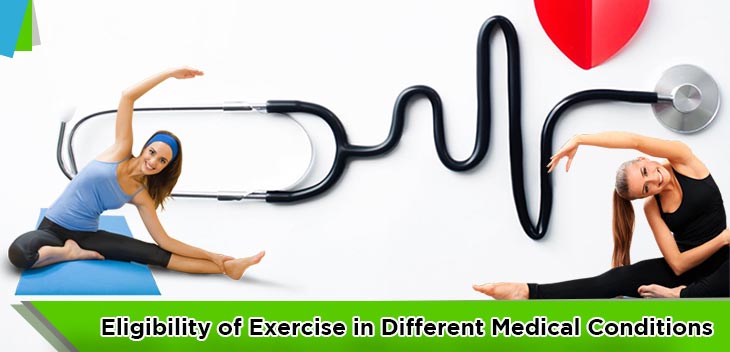Having a medical condition doesn’t mean that you should give up on exercise, sports, and recreational hanging out with your friends in sports settings. Of course, every medical condition is different, but with a bit of research and caution, there’s no reason not to exercise.
If you’re having one of the most common medical conditions out there, you’re in the right place. After doing thorough research for you, we compiled this post for you. All you need is to find your medical condition and learn what exercises you can do, what you shouldn’t do, and how to take care of yourself. In most cases, exercise can benefit certain conditions and improve overall health, so it’s no time to give up on yourself!
Exercise in Different Medical Conditions
Exercising doesn’t mean you have to lift weights. And one of the things you should never do is use a medical condition as an excuse not to work out. With a huge aspect of exercises you can choose from, exercising with any medical condition is possible.
However, just like with exercising without a medical condition, it’s important to stay cautious by doing your research and ensuring you do each exercise with the proper form. While it’s hard to give general advice on what exercises fit you perfectly without knowing your medical condition, down below, we’ll show you some of the best exercises in different medical conditions.
Can You Exercise After Acupuncture?

Now, you might think that acupuncture is fairly harmless, but it’s still a medical condition and you should be cautious exercising after acupuncture. Why?
Sweat is one of the biggest reasons why you shouldn’t exercise since it puts you at risk of an infection. Also, some experts claim that putting your body under strain again can undo the effects of acupuncture.
Therefore, it’s best to lay off exercise for a while after acupuncture, but if you really want to do some exercise, try staying active without sweating too much and without doing so in unclean environments. Unclean environments can also increase the risk of an infection. However, if you would like to give yourself a well-deserved break, laying off exercise at least for a day or two after acupuncture is highly recommended.
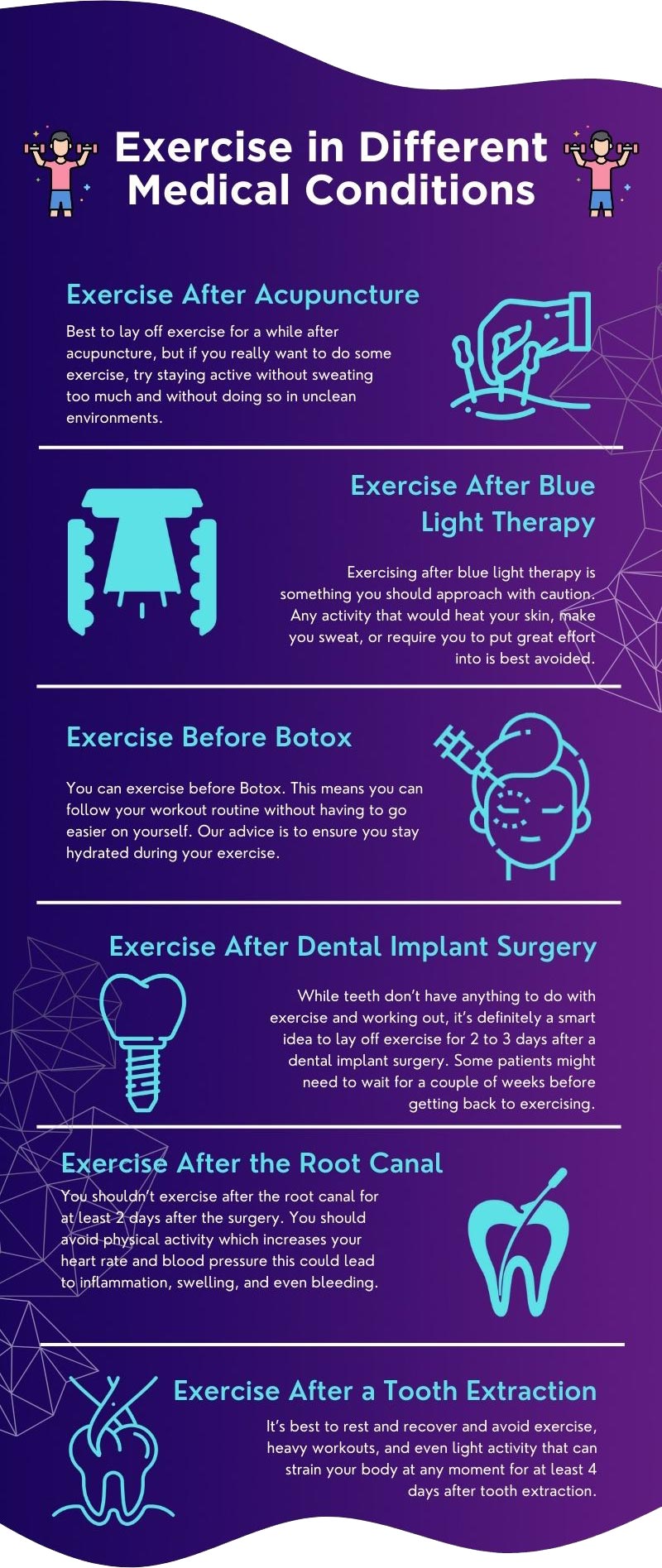
Can You Exercise After Blue Light Therapy?
Exercising after blue light therapy is something you should approach with caution. Any activity that would heat your skin, make you sweat, or require you to put great effort into is best avoided.
If you can’t stay without exercise, the good news is that you should take only 2 days after blue light therapy before you can get back into your workout routine. This is relatively good considering that your skin needs anywhere between two to six weeks to fully recover after blue light therapy.
Another good piece of advice is to ensure your skin care products are also non-irritating and non-clogging, as this could also lead to a potential risk after blue light therapy and it’s as important as laying off exercise for a couple of days. When your skin isn’t peeling anymore, that’s a good sign you can go back to exercising.
Can You Exercise Before Botox?
Botox is something many people are excited about and while you’ll be informed of many general rules to follow and things to avoid, doctors might not tell you anything about exercising before or after the operation.
The good news is that you can exercise before Botox. This means you can follow your workout routine without having to go easier on yourself. Our advice is to ensure you stay hydrated during your exercise. In fact, certain claims exercising before Botox can actually give you benefits and a slight boost. The claim says that if you exercise a couple of hours before the Botox application and then don’t exercise for at least 24 hours after the application, you can benefit more from the application. However, this is something we strongly suggest looking into!
One thing you can’t do is go back to exercising right after the Botox. Give exercising a break of up to 2 days before you go back to your workout routine.
How Soon After Dental Implant Surgery Can I Exercise?
While teeth don’t have anything to do with exercise and working out, it’s definitely a smart idea to lay off exercise for 2 to 3 days after a dental implant surgery. Some patients might need to wait for a couple of weeks before getting back to exercising.
Everyone’s body is different and this depends on the patient’s body, but also on how well did the procedure go. The number of implants placed can also be an important factor, as how difficult was the operation, and even how well is your body healing and adapting to the implants. Of course, overall general health and how you feel will also determine your desire for exercise.
It’s important to listen to your body and you’ll feel if you’re ready. If you’re unsure, it’s best to rest for a little longer before going back to it. When you get back to your exercises, it’s also worth noting that you should ease into it.
Can I Exercise After the Root Canal?
Many exercise after the root canal and it’s often one of the most overlooked medical conditions we have on our list. No, you shouldn’t exercise after the root canal for at least 2 days after the surgery.
If you exercise sooner than you should, this could lead to inflammation, swelling, and even bleeding. Even chewing and biting with the treated tooth can lead to issues, so you really need to ease it into exercise. You should avoid physical activity which increases your heart rate and blood pressure, as this could lead to earlier-mentioned problems.
One thing you should especially avoid is weightlifting since this will most likely lead to issues, pain, and possible complications. Unfortunately, this is something dentists and doctors forget to tell you, but it’s a crucial piece of information if you’d like your tooth to recover as quickly as possible after the root canal.
How Long Should You Wait to Exercise After a Tooth Extraction?
Gums, just like any other part of our body, need rest and time to heal which means that exercising right after a tooth extraction isn’t recommended. Even light exercise can prolong the healing period and it could lead to bigger complications and issues.
It’s best to rest and recover and avoid exercise, heavy workouts, and even light activity that can strain your body at any moment for at least 4 days after tooth extraction. While some people might be fine and ready to exercise after only 2 days, it’s recommended to wait a little longer because it’s hard to tell if your body heals faster or slower.
Some people need up to a week and if you’re not feeling ready after 4 days, it’s best to give yourself a little bit more time and consult yourself with a professional if you still don’t feel ready after the initial week. It’s better to give yourself time than to cause more pain, and bleeding, and prolong the healing process that is already painful enough.
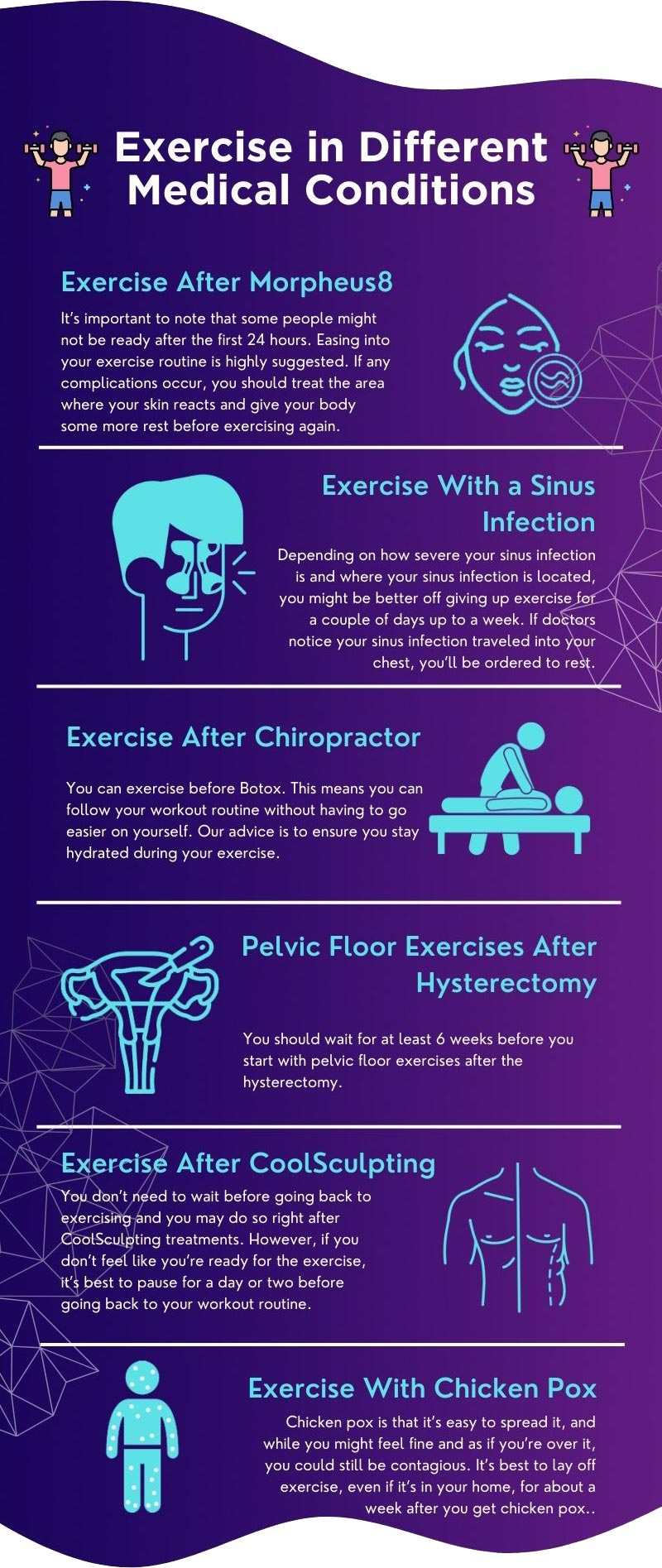
How Soon Can You Exercise After Morpheus8?
People might overlook the effects of Morpheus8, but it’s still a medical condition that requires your body to have time off to heal properly. Compared to other health conditions from our list, Morpheus8 requires less recovery time. You should avoid exercise right after the Morpheus8, but you can go back to exercise and your workout routine 24 hours after the operation.
It’s important to note that some people might not be ready after the first 24 hours. Easing into your exercise routine is highly suggested. If any complications occur, you should treat the area where your skin reacts and give your body some more rest before exercising again.
The biggest issue is sweat which can cause reactions to certain parts of your skin. What you also shouldn’t do is put makeup on your face, expose yourself to the sun, go to the sauna, have a hot shower, or visit steam rooms.
Can I Exercise With a Sinus Infection?
Did you ever have a clogged nose, painful sinuses, or a strong sinus headache, only to get some relief after a good walk? Exercising with a sinus infection can actually give you a slight relief, but it’s important to note that this might not be suggested to everyone.
Depending on how severe your sinus infection is and where your sinus infection is located, you might be better off giving up exercise for a couple of days up to a week. If doctors notice your sinus infection traveled into your chest, you’ll be ordered to rest.
In light cases of a sinus infection, light exercise can increase your body’s circulation, which can benefit you by releasing the sinus pressure and congestion. It can even help speed up nasal discharge. One thing you should avoid when you have a sinus infection, no matter the severity, is balance exercises. Any exercise that requires your balance might have you struggle with it and it won’t benefit your sinuses at all.
How Long After Chiropractor Can I Exercise?
While many people go straight into exercise after visiting a chiropractor, it’s recommended to wait at least half an hour. This is often overlooked, but it’s also a very small time frame, so many people who aren’t aware of it, still give their body enough rest by not getting to the gym immediately.
It’s important to give your body, muscles, and joints time to settle back in, and while your muscles catch up, it’s recommended to ease into your workout without putting your body under a lot of strain at first. If you plan on lifting weights, it’s highly recommended to wait at least 24 hours before pushing your body near its limits. Even stretching after a chiropractor isn’t good for some so it’s best to consult yourself with your chiropractor first before doing anything that wouldn’t benefit your body afterward.
When to Start Pelvic Floor Exercises After Hysterectomy?
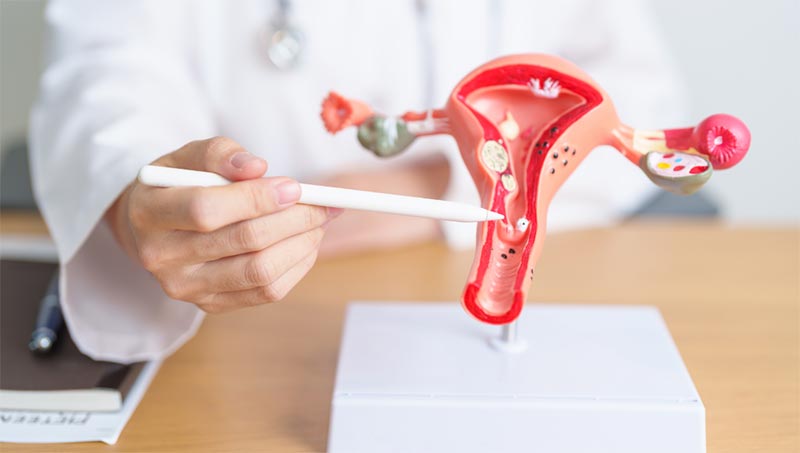
This is one of the most common questions and it’s best to be researched, so you’re taking good care of your body by ensuring you exercise at the right time after a hysterectomy. Hysterectomy is often a decently painful operation where you can feel pain where the cut’s been made for about 4 to 8 weeks after the operation.
Therefore, you should wait for at least 6 weeks before you start with pelvic floor exercises after the hysterectomy. It’s the most important eligibility of exercises in different medical conditions since it’s the one that takes the recovery time from all medical conditions we listed in this article.
The amount of time you should wait before starting pelvic floor exercises after a hysterectomy also depends on the way your body recovers, the pain level you experience, and how well the procedure goes in the first place. Some might feel ready to start the exercise after 4 weeks, but waiting for at least 6 or even 8 weeks for some is most recommended. This is also something that’ll be confirmed by professionals.
If you feel healthy and ready to exercise, starting in the 6th week after the operation is helpful since it will help strengthen the body and provide benefits associated with pelvic floor exercises. However, if you’re not ready yet, resting for the full length of recovery, which is about 8 weeks is still a good thing to do. One thing you should never do is push yourself when you don’t feel ready. Listening to your body will tell you a lot and with hysterectomy being one of the most demanding and challenging operations to recover from on our list, it’s important to become fully healthy before going into any rigorous training, exercising, and weightlifting.
Can You Exercise After CoolSculpting?
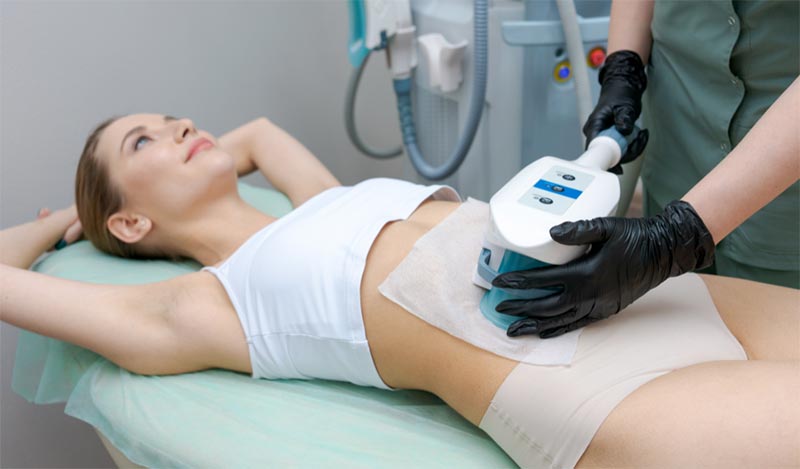
CoolSculpting is one of the ways you can treat and kill your fat cells to reduce stubborn fat spots on your body that won’t go away even after rigorous exercise. The good news is that you don’t need to wait before going back to exercising and you may do so right after CoolSculpting treatments.
In fact, certain claims exercising straight after the CoolSculpting session can help speed up the process and ensure you receive faster results. Of course, this is one of the claims we highly recommend looking into further.
What’s even better yet is that you don’t need to ease into your training and you can go on with your exercise as usual, including weight lifting. This is one of the rare medical conditions you don’t have to worry about since it isn’t very demanding on your body. However, if you don’t feel like you’re ready for the exercise, it’s best to pause for a day or two before going back to your workout routine. If needed, you can take a longer break as well. Since CoolSculpting is done by professionals, you can also ask for their advice and follow the guidelines they explain before you begin the process and after every session.
Can You Exercise With Chicken Pox?
One thing about chicken pox is that it’s easy to spread it, and while you might feel fine and as if you’re over it, you could still be contagious. Everyone else who’s not been exposed to chicken pox and hasn’t had it before could potentially get the virus, so going to places where people exercise such as sporting and training ambients or the gym is something you shouldn’t do.
This means that you should rest and don’t go back to activities you don’t do every day. Chicken pox could make you itch enough and breaking sweat can make itching a lot more difficult to handle. Therefore, even if you’re feeling fine, you should still stay away from public areas. If you’re thinking of exercising at home, be aware that exercising isn’t bad for your body when you have chicken pox, but sweat can make itching a lot worse.
Itching that’s harder to resist can lead to skin irritations, even when you’re not contributing to the rash yourself. The general rule of thumb is that you stop being contagious 1 to 2 days after the rash starts. However, it only takes 5 to 7 days after the rash and itching for the blisters to dry. With that being said, it’s best to lay off exercise, even if it’s in your home, for about a week after you get chicken pox.
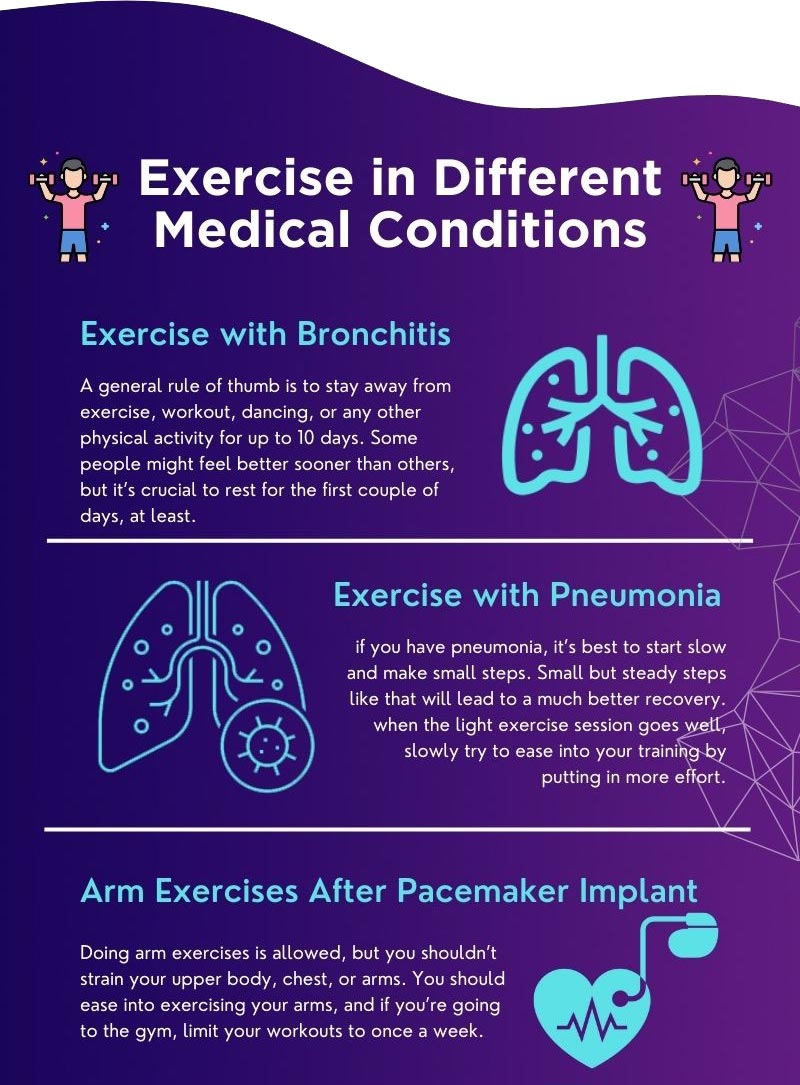
Is it Safe to Exercise with Bronchitis?
Bronchitis is often associated with dry cough, which is the most common symptom every person experiences. Dry cough is hard to deal with when you’re exercising and working out, but there are also many more reasons why you should ease down your exercising when you have bronchitis.
A general rule of thumb is to stay away from exercise, workout, dancing, or any other physical activity for up to 10 days. Some people might feel better sooner than others, but it’s crucial to rest for the first couple of days, at least. A dry cough associated with bronchitis can last much longer, so don’t be surprised to experience it for a couple of weeks.
After the first initial week passes, you can slowly ease into exercising again, even if you have a dry cough. But be aware that a dry cough can make things difficult for certain exercises, and even for physical activities such as dancing. If your symptoms improve but you still can’t do much exercising due to a dry cough, you can either slow things down or give yourself another break from exercising. The second break will depend on how your body reacts and heals, so give yourself at least 3 to 5 days before you give exercising another try. While exercising might not slow down your healing process, getting even lighter physical activities done after bronchitis can be extremely difficult, so it’s important to take it seriously, even if you’re feeling slightly better. Don’t jump into exercising straight away.
Is it OK to Exercise with Pneumonia?
Regaining strength after pneumonia is super important and exercise is the best way to do it. But how soon should you start working out and is it okay to exercise with pneumonia? Light exercise should definitely help, but you have to determine if light exercise feels good for you. If not, you should rest for a little longer before you try exercising again.
An exercise that doesn’t worsen the cough or cause trouble breathing is okay. Only when the light exercise session goes well, slowly try to ease into your training by putting in more effort. However, don’t rush the process because your body might not be ready to do even half of what you used to. But don’t worry, you will get back in shape, but if you have pneumonia, it’s best to start slow and make small steps. Small but steady steps like that will lead to a much better recovery.
Another important thing to do is to drink a lot of water or other liquids to stay hydrated. You’ve probably been told this by your doctor, but it’s super important to hydrate well if you decide to exercise. But even when you get to exercise when you have pneumonia, don’t forget that your body still needs plenty of rest so you should still rest properly. Not resting enough can lead to a longer recovery time and complications.
Can I do Arm Exercises After the Pacemaker Implant?
Pacemaker implants can be tricky to recover for some because you’re allowed to do certain things, but still have to be careful of how you do them. For example, doing arm exercises is allowed, but you shouldn’t strain your upper body, chest, or arms. You should ease into exercising your arms, and if you’re going to the gym, limit your workouts to once a week.
While this might not seem much, it’s really important to understand straining yourself isn’t good, and while you might feel good in the gym or at certain moments, it’s not wise to lift anything heavy. Another thing you shouldn’t do is lift your arm on the side of the operation for up to 6 weeks.
On the bright side, moderate arm exercises can help reduce frozen shoulder symptoms and are often recommended by doctors. Light to moderate activity is the best way to recover and settle into your daily life after pacemaker placement. Besides arm exercise, walking is another great way to exercise.
Things you should never do when you have a pacemaker implant is heavy lifting. Anything over 10 pounds can be dangerous as it could put a strain on the body. Besides lifting, you should also avoid pulling, pushing, and twisting exercises. These exercises can cause pressure where the pacemaker is placed and this could lead to serious issues. It’s best to consult with a professional about the maximum acceptable heart rate for your body.
Conclusion
Exercises in different medical conditions depends on the condition itself, but it also highly depends on the individual. While we’re the same human beings, everyone’s body reacts differently to certain things and aspects of life.
Hopefully, we covered the most common medical conditions and have saved you tons of time on research. Most medical conditions require you to lay off exercise for a while, but easing back into it can also be beneficial for the body, and of course, the mind of an individual (especially post-operation).
FAQs – Exercises in Different Medical Conditions
What are five common causes of injury or illness related to fitness?
The most common causes of injury related to fitness include incorrect form while performing the exercise, overtraining, improving the intensity too quickly, running and jumping on hard surfaces, and wearing shoes that don’t provide good enough support.
How can common fitness injuries be treated at home?
Luckily, most common fitness injuries can be treated at home. Resting is one of the best ways to treat an injury, in combination with ice, compression, and elevating the injury.
What is the most common injury from physical activity?
The most common injury from physical activity is a knee injury, followed by a shoulder injury, concussion, and shin splints.
What lifting exercise causes the most injuries?
Deadlift is the most common lifting exercise that causes the most injuries due to its complexity. While it’s a compound exercise that works the most muscles, it’s also the exercise that has the most important things to get right to achieve a proper form. Not doing so can lead to injuries related to the back, legs, shoulders, and more.
What is the most common cause of injury as a result of fitness training?
The most common injury as a result of fitness training is the overuse injury. This is related to sports where a certain movement is repeated over and over again, leading to too much physical activity too quickly at one or a couple of targeted spots. On top of that, improper technique is another common cause of injury.
How long does it take to regain fitness after injury?
Regaining your fitness after injury will depend on the injury and your body. However, you can regain ¼ of your fitness in the first 10 to 14 days, which is a good step forward.

